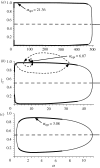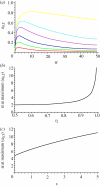Limits to the evolution of assortative mating by female choice under restricted gene flow
- PMID: 20685708
- PMCID: PMC3013393
- DOI: 10.1098/rspb.2010.1174
Limits to the evolution of assortative mating by female choice under restricted gene flow
Abstract
The evolution of assortative mating is a key component of the process of speciation with gene flow. Several recent theoretical studies have pointed out, however, that sexual selection which can result from assortative mating may cause it to plateau at an intermediate level; this is primarily owing to search costs of individuals with extreme phenotypes and to assortative preferences developed by individuals with intermediate phenotypes. I explore the limitations of assortative mating further by analysing a simple model in which these factors have been removed. Specifically, I use a haploid two-population model to ask whether the existence of assortative mating is sufficient to drive the further evolution of assortative mating. I find that a weakening in the effective strength of sexual selection with strong assortment leads to the existence of both a peak level of trait differentiation and the evolution of an intermediate level of assortative mating that will cause that peak. This result is robust to the inclusion of local adaptation and different genetic architecture of the trait. The results imply the existence of fundamental limits to the evolution of assortment via sexual selection in this situation, with which other factors, such as search costs, may interact.
Figures





Similar articles
-
Geography, assortative mating, and the effects of sexual selection on speciation with gene flow.Evol Appl. 2015 Aug 26;9(1):91-102. doi: 10.1111/eva.12296. eCollection 2016 Jan. Evol Appl. 2015. PMID: 27087841 Free PMC article. Review.
-
Frequency-dependent selection and the evolution of assortative mating.Genetics. 2008 Aug;179(4):2091-112. doi: 10.1534/genetics.107.084418. Epub 2008 Jul 27. Genetics. 2008. PMID: 18660541 Free PMC article.
-
Divergence and evolution of assortative mating in a polygenic trait model of speciation with gene flow.Evolution. 2017 Jun;71(6):1478-1493. doi: 10.1111/evo.13252. Epub 2017 May 16. Evolution. 2017. PMID: 28419447
-
Mechanisms of Assortative Mating in Speciation with Gene Flow: Connecting Theory and Empirical Research.Am Nat. 2018 Jan;191(1):1-20. doi: 10.1086/694889. Epub 2017 Nov 21. Am Nat. 2018. PMID: 29244561
-
On the origin of species by means of assortative mating.Proc Biol Sci. 1998 Dec 7;265(1412):2273-8. doi: 10.1098/rspb.1998.0570. Proc Biol Sci. 1998. PMID: 9881472 Free PMC article. Review.
Cited by
-
The effectiveness of pseudomagic traits in promoting premating isolation.Proc Biol Sci. 2023 Mar 8;290(1994):20222108. doi: 10.1098/rspb.2022.2108. Epub 2023 Mar 8. Proc Biol Sci. 2023. PMID: 36883275 Free PMC article.
-
Pairing dynamics and the origin of species.Proc Biol Sci. 2012 Mar 22;279(1731):1085-92. doi: 10.1098/rspb.2011.1549. Epub 2011 Sep 21. Proc Biol Sci. 2012. PMID: 21937496 Free PMC article.
-
A stochastic model for speciation by mating preferences.J Math Biol. 2018 May;76(6):1421-1463. doi: 10.1007/s00285-017-1175-9. Epub 2017 Sep 15. J Math Biol. 2018. PMID: 28914350
-
Geography, assortative mating, and the effects of sexual selection on speciation with gene flow.Evol Appl. 2015 Aug 26;9(1):91-102. doi: 10.1111/eva.12296. eCollection 2016 Jan. Evol Appl. 2015. PMID: 27087841 Free PMC article. Review.
-
Polygamy slows down population divergence in shorebirds.Evolution. 2017 May;71(5):1313-1326. doi: 10.1111/evo.13212. Epub 2017 Apr 10. Evolution. 2017. PMID: 28233288 Free PMC article.
References
-
- Coyne J. A., Orr H. A. 2004. Speciation. Sunderland, MA: Sinauer Associates
-
- Mayr E. 1942. Systematics and the origin of species. New York, NY: Columbia University Press
-
- Wiley E. O. 1978. The evolutionary species concept reconsidered. Syst. Zool. 27, 17–2610.2307/2412809 (doi:10.2307/2412809) - DOI - DOI
-
- Turelli M., Barton N. H., Coyne J. A. 2001. Theory and speciation. Trends Ecol. Evol. 16, 330–34310.1016/S0169-5347(01)02177-2 (doi:10.1016/S0169-5347(01)02177-2) - DOI - DOI - PubMed
-
- Moore J. A. 1957. An embryologist's view of the species concept. In The species problem (ed. Mayr E.), pp. 325–338 Washington, DC: American Association for the Advancement of Science
Publication types
MeSH terms
LinkOut - more resources
Full Text Sources

